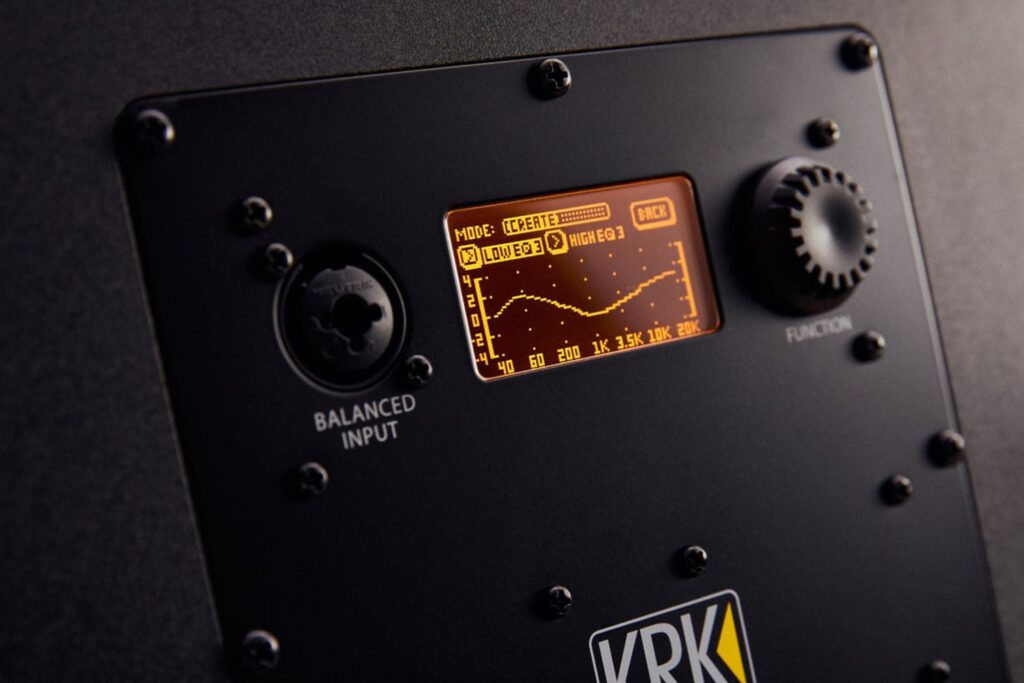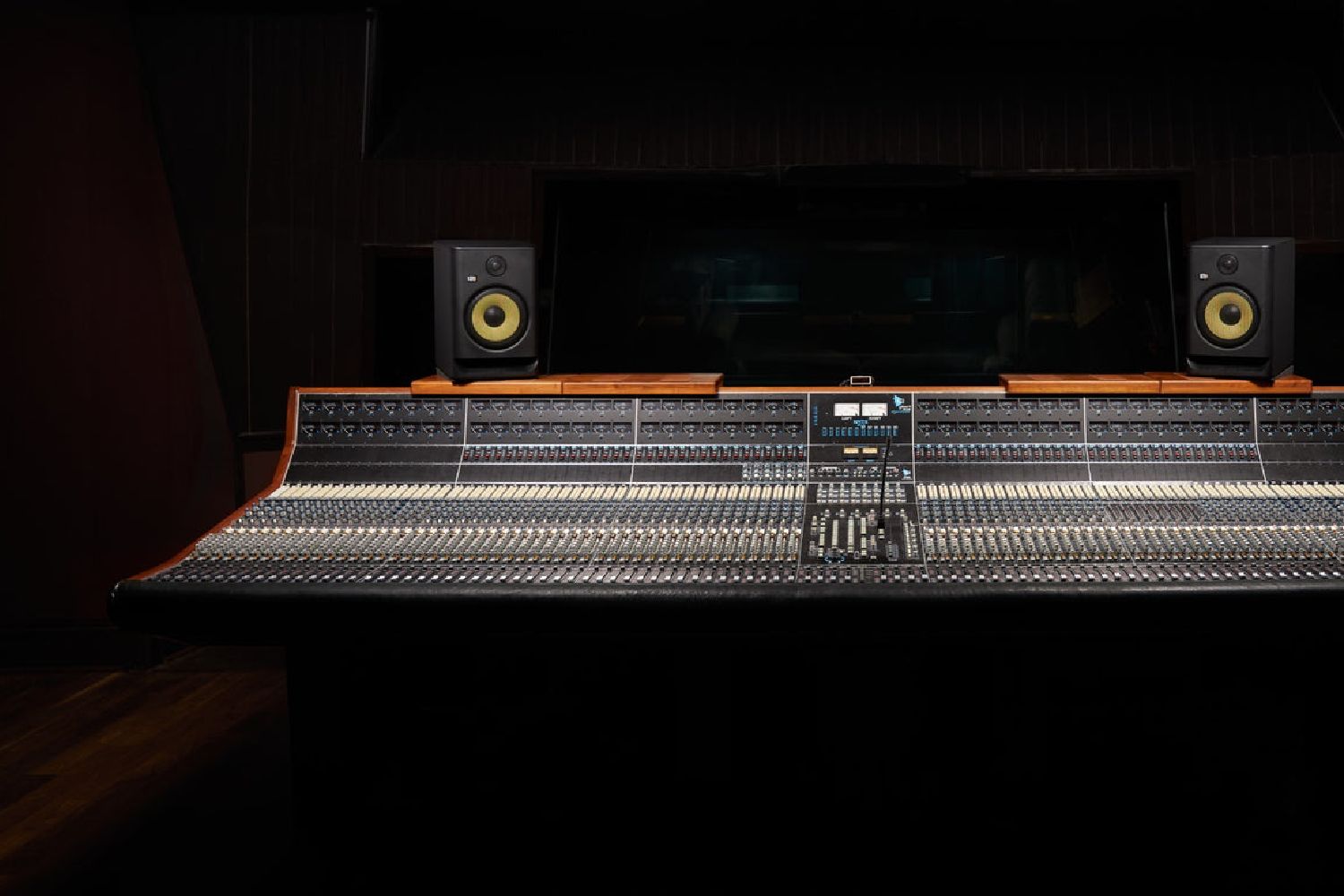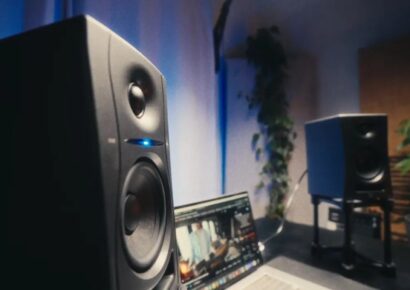The yellow cone of a KRK monitor has, over the past twenty years, become a stalwart in just about every studio, from professional recording and editing suites, right down to compact home setups.
I don’t know how many of the first generation KRK Rokit 5 speakers I have seen and heard over the years, but it is a staggeringly high number. Since then, every generation has improved on the past with subtle updates. Now, the new Rokit Generation 5 jumps well ahead with an upgraded look, new amplifier design and quite possibly the best built-in DSP in its class. These are the studio monitors that all current Rokit owners will want to upgrade to!
KRK Rokit 5
Let’s start with the obvious change, the look. It’s been a slight shifting of cabinet angles over the years that has defined how we see the Rokit 5, but what I’m looking at now is in a whole new league. KRK have stepped it up with an entirely new cabinet design, both internally and on the surface. We’ve gone back to more of a block shape, yet still with soft curves on the sides to keep these looking sexy, whilst allowing sound deflection to be kept to a minimum. The front porting looks to be more of an organic curve, carved out of the housing in a minimal design concept. In short, these look about five times their ticket price. On top of that, both the tweeter and woofer are now protected by a black powder coated metal grill. This still enables the yellow cone to be seen, but mutes the tone slightly. Aside from the aesthetic it offers, the grills really excite me as I am not a fan of seeing tweeter domes pushed in by enquiring fingertips.
Read all the latest features, columns and more here.
TRS/XLR input
Now, once you’ve looked over the front, I am sure any curious mind, like mine, will turn the box around to see what’s hiding out back. This is where we get an idea of everything that KRK have going on with the Rokit Generation 5 monitors. And they’re not kidding around. Like the changes we saw in Generation 4, these are designed as a set-and-forget monitor, you have a combination TRS/XLR input, a power switch, a jog wheel and an LCD screen. That’s it. Gone are the dip switches. Gone are any unnecessary inputs and outputs. Gone are the Volume and Tone knobs of older models. With the jog wheel, you are able to set the volume, adjust the tone, and control a host of onboard DSP voicings and boundary tuning features. Once you’ve set these up for your listening space, you only need to worry about the power, and everything else is left untouched.
So, what’s under the hood? The new bi-amplified design offers a separate amplifier for both tweeter and woofer, with a total of 120-watts of Class D power. This has been designed to offer an absolute minimum of operating noise, whilst delivering more than enough volume for nearfield monitoring and critical listening. Furthermore, the separation of power between the amplifiers reduces the overall operating heat, removing the need for external heat sinks and allowing longer operating times without affecting the performance of the units.
What this all means is that you have incredible control over how your monitors operate in the space you’re using them. Firstly, the three voicings allow you to have the monitors set up for three different listening tasks. These are the Mix, Focus and Create modes that all deliver a different EQ and stereo spread to better enhance each of these stages of your music making. Whilst many will leave their monitors set to the Mix voicing, as they will be primarily used for mixing, it’s in the production, recording, editing and critical listening stages before the final mix that the other voicings will get a great many users excited. The Create mode offers a more dynamic, vibrant and lively sound reproduction so you can hear and get inspired by your music, and an ideal setting for casual listening when you just want to play your favourite music. When it comes to hearing vocals, the Focus mode emphasises the mid-range more, so they jump out in the mix. Both these modes are very handy for different situations in the production process before settling in for the precision of the Mix mode to polish it all off. In essence, this is like having three separate sets of speakers, all in the on pair of monitors. You just need to swap between the voicing mode to suit the task at hand.

The onboard DSP offers room control, so you can tame the space for that critical mix stage. There are 25 boundary and EQ combinations, to ensure you’re hearing the flattest response possible even after your immediate environment takes its toll on the sound. This is a wonderful tool for anyone setting up a home studio where the room may not be acoustically treated as well as a professional studio would. This is aided by the KRK app for mobile devices that allows you to properly tune your room so that you’re hearing the Rokit Generation 5 speakers at their very best. Think of the old KRK ERGO system that involved a reference microphone and a desktop hardware device connected to your monitor speakers at all times. Whilst a great system, it was an investment on top of your monitors and required additional hardware. The Rokit Generation 5 does away with the need for all those peripherals with the inbuilt DSP and KRK app.
KRK app for mobile devices
The KRK Rokit Generation 5 monitors are a long way ahead of the humble origins of the original Rokit 5, which was a game changer in its own right. I think it goes without saying that you should hear a pair of these to understand that they are punching well above their weight. Get into your local KRK dealer and have a listen right away. I don’t think you’ll be disappointed. And best of all, when you get your own pair home, you’ll be able to set them up in your space to deliver the same quality of sound reproduction as you would expect in any professional environment.
For local enquiries, visit Jands.







